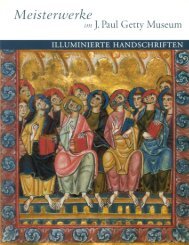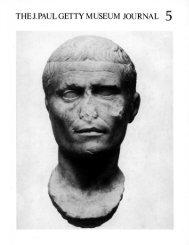The J. Paul Getty Museum Journal Volume 15 1987
The J. Paul Getty Museum Journal Volume 15 1987
The J. Paul Getty Museum Journal Volume 15 1987
You also want an ePaper? Increase the reach of your titles
YUMPU automatically turns print PDFs into web optimized ePapers that Google loves.
10 SpierFigure 5a. Chain with three pendants set with bandedagates. Found Kuban, Russia, circa sixth century.Gold. Leningrad, State Hermitage2134/1. Photo: Courtesy State Hermitage,Leningrad.ing, making it difficult to see the engraved pattern. Itappears to be a facing, nimbate bust rather than thecross and acanthus leaf design. Other details, such asthe circular shape, the border of punched dots, and theadded beaded wire, however, all correspond to themain series of pendants under consideration. This particularexample served as a reliquary.With the exception of the last (No. 10), the pendantsall share a basic decorative pattern: a central cross surroundedby engraved acanthus leaves placed betweenthe arms and sometimes additional hatched lines in thefield. <strong>The</strong> form of the cross varies, as does the quality ofthe engraving and the care given to the pattern. <strong>The</strong>cross may have arms of equal length with flaring ends(Nos. 1—3); it may have longer vertical than horizontalbranches (No. 4; two of the pendants in No. 5; and Nos.7, 8); or it may approach the form of a Maltese cross(Nos. 6, 9). In one example (No. 5) the cross is modifiedto become an IX monogram.Originally the intention was to make a simple, underratedcross subtly stand out from the complexbackground of floral decoration that outlines it. <strong>The</strong>most successful examples are in Malibu and New York(Nos. 1, 2), where the carefully engraved acanthus patternsare bolder than the cross. <strong>The</strong> crosses on the subsequentpendants are more easily visible, and theacanthus leaves hence become more stylized; they nolonger appear rounded in shape with curving veins butas simple oval or triangular areas with a central spineand straighter veins. <strong>The</strong>y fill the fields in a more haphazardmanner and may degenerate to a state where theleaves are almost indistinguishable among the lines(No. 7) or are replaced entirely by simple hatch marks(No. 9).Although the pattern of acanthus leaves outlining across does not appear elsewhere in Byzantine art, theuse of the acanthus leaf as a subsidiary decorative deviceon metalwork was very popular. It is frequently seenengraved on silver plate in the fourth century A.D. andcontinues into the sixth and seventh centuries, as Rosshas observed. 12Elaborate patterns based on acanthusleaves are also typically found engraved below the bowlsof sixth- and seventh-century, silver liturgical spoons. 13A related pattern of acanthus leaves and cross is seenon the gold box-pendant reliquary of Saint Zachariassaid to be from Constantinople and now in DumbartonOaks (figs. 10a—c). 14<strong>The</strong> back, carefully executed inFigure 5b. Detail of figure 5a.Breen Bredemeyer.Drawing by Martha12. Ross, D.O. Cat., vol. 1, no. 7, p. 9, and cf. E. Dodd, ByzantineSilver Treasures (Bern, 1973), pp. 12—13. In addition, the cross andacanthus leaf pattern of the pendants is seen as a decorative motif inthe borders of a pair of unpublished sixth- or seventh-century, silver








